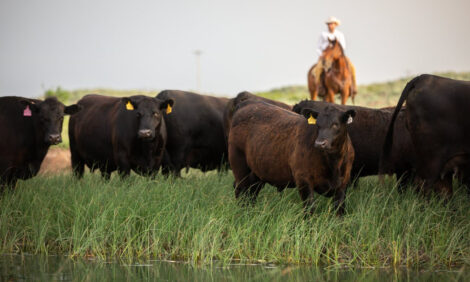



Livestock And Products Annual Report - Mexico 2009
Due to the international economic crisis, weak demand, a volatile exchange rate and lower gross family income, the rate of growth for red meat consumption in Mexico is expected to decline as many middle- and lower-income consumers are expected to substitute relatively cheaper protein sources for red meat, according to the USDA Foreign Agricultural Service.Production:
Beef
Cattle production for 2010 is forecast to increase only marginally as compared to 2009 (0.3 per cent), reflecting decreased demand for feeding and export cattle due to lower beef consumption by lower-income families and reduction of exports due to the negative effect of COOL regulation on export prices. This continues the trend that was observed in 2009, as cattle production estimates only increased about 0.3 per cent compared to 2008 levels.
The 2008 cattle production estimates have been revised downward from the previous report and are now approximately 2 per cent lower than the 2007 levels. The change reflects the numbers of the recently-published INEGI 2007 census as well as private sector estimates.
Total cattle inventories for 2010 are expected to decline 2.3 per cent as a result of lower rates of production and imports that failed to compensate for 2009 slaughter loss, and export levels. Total inventories for 2009 and 2008 have been revised downward to reflect the above-mentioned trend, based on INEGI's 2007 census data.
The 2008 beginning stocks estimates for dairy and beef cows were revised upward and downward, respectively, following the release of the official INEGI data (2007). The 2008 beginning stocks estimates were based on the INEGI and industry trends.
Beef production for 2010 is forecast to increase only 0.3 per cent due to an expected decline in consumer demand resulting from the economic downturn, which also increases the price of inputs such as petroleum. Beef production for 2009 and 2008 was revised to match official data.
Slaughtering for 2010 is forecast to increase 0.1 per cent, with slaughtering for 2009 increasing by 2 per cent. Meanwhile, beef production estimates are forecast to increase 1.6 per cent in 2009 and 0.3 per cent in 2010. In spite of the increasing trend in production, red-meat consumption will recover slowly as family incomes increase.
Despite the international economic crisis, the beef industry has many investment projects aimed at increasing slaughtering and packing facilities. Many TIF [1] plants have begun adding value to viscera by selling it packed, not only for the domestic market, but also for export.
Additionally, TIF plants are increasing the slaughter of animals that come from suppliers with “trusty supplier” certification. This certification guarantees that cattlemen feed animals without using prohibited feed supplements such as Clenbuterol.
[1] Federally Inspected Facilities
Consumption:
The consumption of beef and pork meat will not increase at the same rate as the population growth for 2009 and 2010, in part because of reduced gross family income resulting in lower red meat consumption and because of a substitution effect by consumers who see poultry as a cheaper and “healthier” protein source that will thereby repress per capita growth of beef and pork meat consumption.
Beef
Beef consumption is expected to grow in 2010 (2.1 per cent), in contrast to the reduction for 2009 (-4.1 per cent) resulting from the effects of the economic crisis on middle- and lower-income consumers’ purchasing decisions and the comparatively higher-price of beef as a protein source.
This type of meat is the first to be substituted in Mexico when family gross income is reduced. Only the upper-middle and higher income consumers do not change their meat consumption habits even in a crisis.
The 2008 beef consumption estimate was revised downward reflecting a lower slaughter level than previously reported. The economic slowdown, the increase of beef prices (particularly imported cuts due to the exchange rate), the reduction of family income, and the higher substitutability of beef meat affected, and continues affecting, beef consumption.
It is hoped that in 2010 the beef meat consumption level will start recovering, thanks to larger quantities of domestic beef available due to an expected policy of feeding and slaughtering traditionally-exported cattle within Mexico. The GOM, ranchers and feeders are working towards an agreement on this policy, which should result in countering meat import reductions due to the strong exchange rate.
Trade:
In general, red meat exports to Mexico are expected to recover slightly in 2010 after a decrease in 2009 and 2008 due to the international economic slowdown that is not only affected by the exchange rate, but also a reduction in consumption of red meat (principally higher-priced beef cuts).
Beef
Mexican cattle exports are forecast to increase 18.9 per cent in 2010 and 25.3 per cent in 2009 after reversing a downward trend which occurred in 2007 and 2008. However, the level in 2010 (1.1 million heads) will be lower than 2006 (1.2 million heads). As previously reported, the decrease in exports of calves to the US is primarily due to a reduced price paid to Mexican exporters, who claim the reduced price is because of the US COOL law.
Cattle imports will increase 67 per cent in 2010 to 25,000 head; following a glaring drop in 2009 in which only 15,000 heads were imported. These figures are 28 and 17 per cent, respectively, of 2008 import levels.
Although Nicaragua, Australia, and New Zealand have been the main suppliers of cattle to Mexico in the past, it appears that in 2009 the US will be the largest supplier, but at a lower level than previous years.
For 2010, Mexican beef exports will most likely not increase because Mexican export prices should be higher than current export prices due to the current peso devaluation. Exports might increase if Mexico finally obtains an animal-sanitary agreement with new markets such as Russia, China and Singapore.
It is important to point out that the Mexican government continues to strengthen its domestic inspection and is now obtaining international equivalences in sanitary procedures which in the past have caused a temporary halt to exports. In 2009, a 7.1 per cent increase (a lower rate than 2008 and 2007) is expected for exports.
The US will continue to be the leading supplier of beef imports. However, the presence of Canada and Chile in the Mexican market are increasing year by year, and it is probable that in 2010 the US will suffer a reduction primarily due to the peso devaluation.
As of the date of publication, the following beef products are still prohibited from entering Mexico from the US due to the finding of BSE in a US cow in December of 2003.
Further Reading
| - | You can view the full report by clicking here. |


